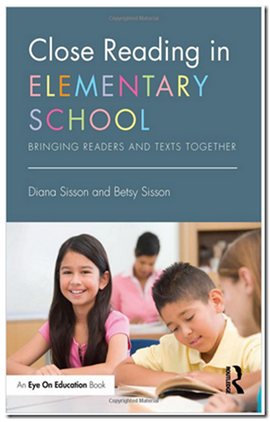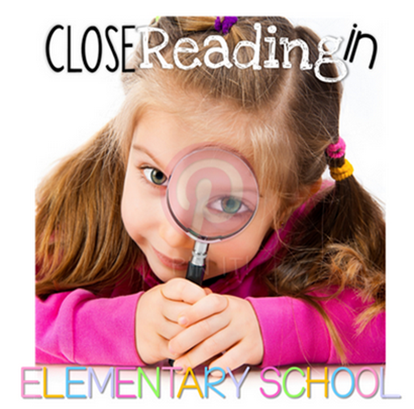
Hi Everyone! I’m here to discuss Chapter 7 of Close Reading in Elementary School with you all. I missed out on Chapter 6’s discussion. If you did too, you can go read it over at Tara’s blog here. I LOVED, LOVED, LOVED this chapter because it focuses on my FAVORITE part of teaching: SMALL GROUP DISCUSSIONS! Let’s dive in, shall
we? If you’re just joining this book study, grab the book below:
Like I mentioned before, my absolute FAVORITE part of teaching is small group time. I treasure the uninterrupted time with my students and LOVE hearing them discuss a text with one another. I especially love small group time because it allows me to step back and gives all my students (the shy AND the outgoing ones) a time to SHINE. Last year, my friend Tracy and I would share the highlights of our day and often times it was about a thought-provoking discussion that took place in small group time. We didn’t know it at the time, but what were leading was called a close talk. Chapter 7 provides us with all kinds of insight on what a close talk is AND what it should look like your classroom. I highlighted many of the important components of this chapter below. 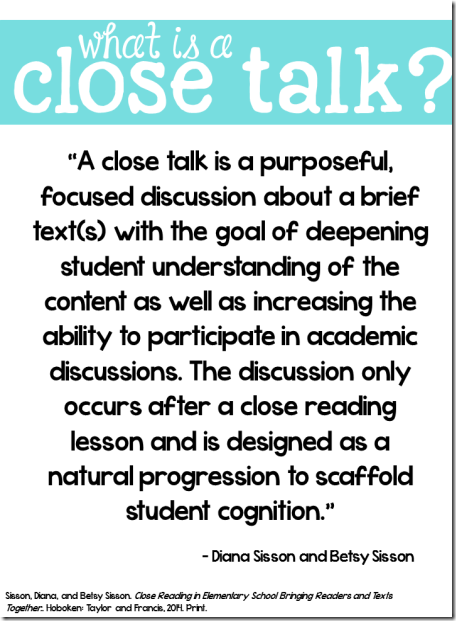 A close talk is a DEEP DISCUSSION about a text. In order to have a deep discussion, the teacher needs to do a little work ahead of time. First and foremost, you MUST read the text before presenting it to your students. This allows you to generate thought-provoking questions. I admit it. I’m guilty of putting a text in front of my students that I didn’t dissect enough prior to our small group meeting. I’m sure you can imagine how that lesson went. If you can’t, here you go: Me: …………………………..………………………………… Students: ……………………………………………………… Me: ……………………………………………………………… Students: ………………………………………………………. Me: Wow! What a wonderful small group discussion today. You all can go back to your Daily 5 rotations now. Okay, it was never THAT bad but you get the point. If we don’t come prepared for small group time, how can we expect our students to come prepared? Here are some tips and procedures that the authors give on how to have a successful close talk in your classroom:
A close talk is a DEEP DISCUSSION about a text. In order to have a deep discussion, the teacher needs to do a little work ahead of time. First and foremost, you MUST read the text before presenting it to your students. This allows you to generate thought-provoking questions. I admit it. I’m guilty of putting a text in front of my students that I didn’t dissect enough prior to our small group meeting. I’m sure you can imagine how that lesson went. If you can’t, here you go: Me: …………………………..………………………………… Students: ……………………………………………………… Me: ……………………………………………………………… Students: ………………………………………………………. Me: Wow! What a wonderful small group discussion today. You all can go back to your Daily 5 rotations now. Okay, it was never THAT bad but you get the point. If we don’t come prepared for small group time, how can we expect our students to come prepared? Here are some tips and procedures that the authors give on how to have a successful close talk in your classroom: 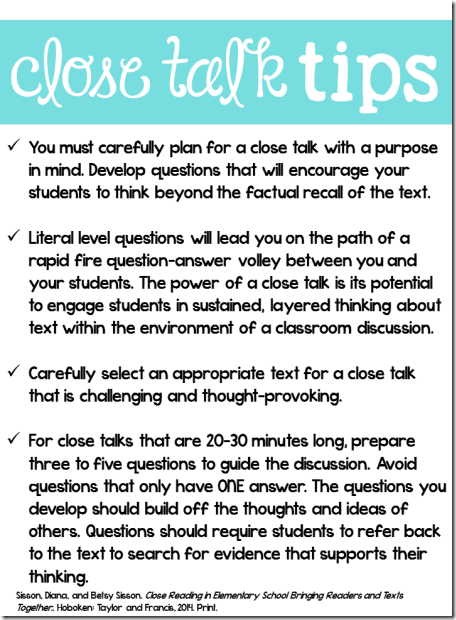
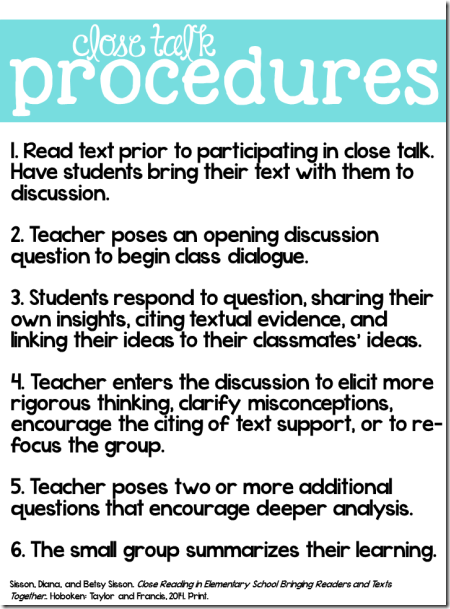 Prior to having a close talk in your classroom, be sure to go over the following rules with your kiddos. The following posters hung near our small group table last year. My students referred to them all throughout our close talks. We would often review the Learn to Listen poster. I think it’s necessary to emphasize that while it’s very important to share our thinking, it’s equally as important to listen to the ideas of others. You can grab the posters HERE.
Prior to having a close talk in your classroom, be sure to go over the following rules with your kiddos. The following posters hung near our small group table last year. My students referred to them all throughout our close talks. We would often review the Learn to Listen poster. I think it’s necessary to emphasize that while it’s very important to share our thinking, it’s equally as important to listen to the ideas of others. You can grab the posters HERE.  Chapter 7 addresses five close talk guidelines. These guidelines are more general than the ones above, but they are great reminders! I suggest adding these to your small group area.
Chapter 7 addresses five close talk guidelines. These guidelines are more general than the ones above, but they are great reminders! I suggest adding these to your small group area. 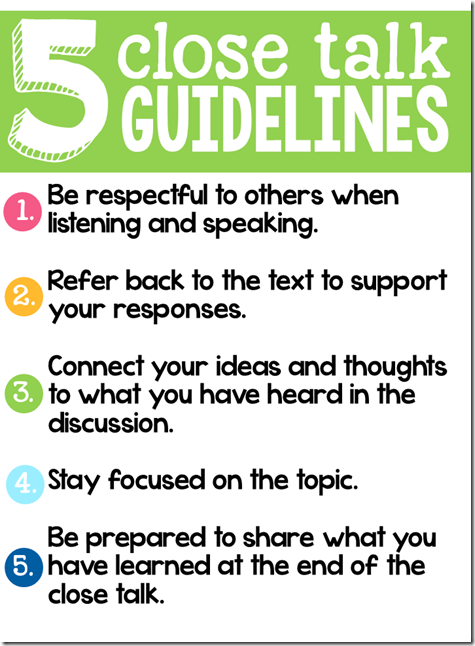
My FAVORITE part of this chapter was the section on the importance of encouraging our students to be active participants. The authors provided us with a rubric to use in our classrooms. I thought that some of the language they used was a little too advanced for first graders, so I made it more kid-friendly. The authors suggest going over this rubric before having a close talk. I would suggest hanging this in your small group area, as well. The goal is to be a “Four Star Participant.”
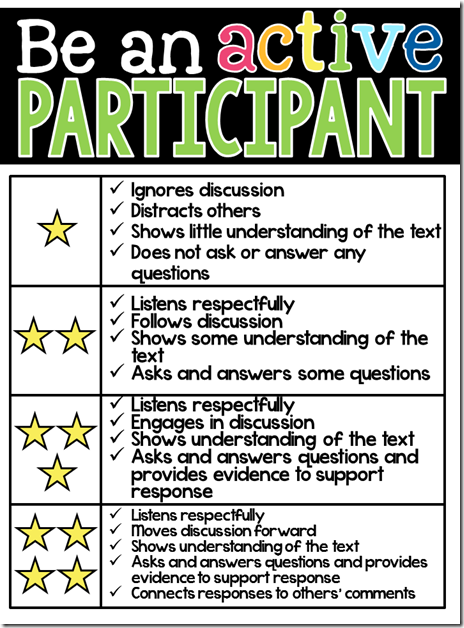 I made this little participation data chart for you, as well. I suggest tracking each student’s participation on this chart. This will come in handy when report card time comes around!
I made this little participation data chart for you, as well. I suggest tracking each student’s participation on this chart. This will come in handy when report card time comes around!
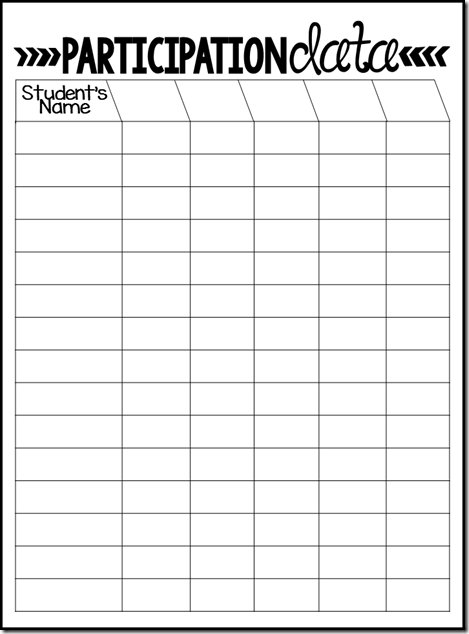
You can grab all of these freebies in my shop. Click HERE to go download. Happy Sunday, my dear friends!


